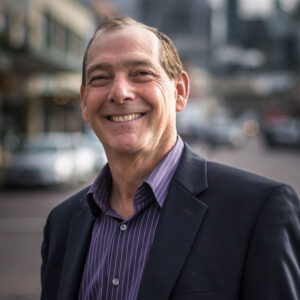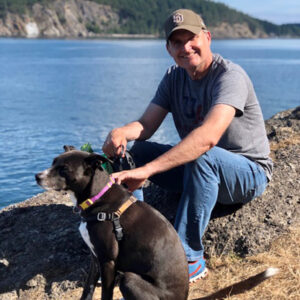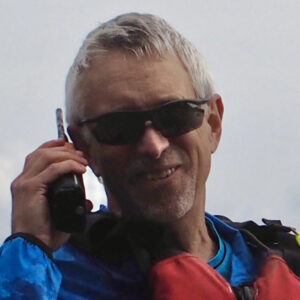Pool Progress “Pool Progress: Behind the Scenes of the Lopez Swim Center” is an eight-part series to keep you informed with project updates, along with interviews from Swim Center experts, leaders, and community members supporting the campaign. This is part three of our eight-part series.
Meet Some of FLIP’s Pool Pros
In recent years, the expertise for the Lopez Swim Center’s planning, implementation, and operation has significantly expanded. Today, nearly 40 volunteers serve on six committees dedicated to project oversight, operations, fundraising, marketing, financing, and advising. Here, we highlight four of FLIP’s volunteer leaders—professionals in their respective fields who are contributing their skills and expertise to create the best swim center possible for the community.
Leading the Creative Charge 
Executive Creative Director and partner of Graphiti, one of Seattle’s top digital creative agencies, Kevin Berger leads the firm’s creative vision and strategic direction. He works with national and global clients including Amazon, Munich Re, Colliers, and Nordstrom. He also has more than a decade of experience in board and volunteer facilitation from working with groups like AIGA, a national organization of design professionals. Graphiti led the rebranding campaign for San Juan Preservation Trust to achieve more inclusive participation in stewarding land conservation efforts. As a FLIP volunteer on the Marketing Committee, Kevin’s focus is creating a cohesive message and visual identity for the Swim Center.
FLIP: What marketing expertise have you and Graphiti brought to this project and how are you guiding the Swim Center’s branding and marketing?
KB: I’ve been able to tap into Graphiti’s broader team and donate some of our services to help support several aspects of FLIP’s marketing. Early on, we developed a communications plan that focused on generating excitement and awareness about the new pool. We also designed several renderings of the new pool to give the public an idea of the experience.
Another area where Graphiti’s team provided support was helping FLIP develop a video from ad agency creative writer (and Lopezian) Dave O’Hare’s written manifesto, which can be found on FLIP’s website. The manifesto grounds the project in a guiding vision; putting it on the website is a way for everyone to be able to see it and share in that vision.
FLIP: Are there any teasers you can share about the Swim Center’s branding effort?
KB: Yes! In collaboration with Dave, we’ve developed our “North Star” brand statement: “To surprise and delight everyone.” We’ll be doing that with opportunities that are inviting, fun, respectful, and, we hope, will generate a lot of enthusiasm. So, I’ll leave that to your imagination to envision where that might lead visually.
FLIP: Why did you join FLIP’s leadership? What most impresses or excites you personally about the project or the leadership?
KB: As a part-time Lopez resident (I’ve been a part of the community for more than a decade), I am invested in the island’s preservation and health. I want to see my community not only become a safer place with regards to water safety but want people of all ages to have a safe and healthy place to gather, exercise, and share new skills. I joined FLIP because I wanted to support a great group of longtime locals who were working towards these same goals. I knew my brand and marketing experience could really help, and I’ve never looked back. It’s been a very positive experience!
Monitoring Construction Efficiency & Cost 
For 40 years, architect Eric Meng has led Studio Meng Strazzara’s design work, serving the Northwest’s leading public institutions, including K12 schools and universities, dozens of public pool facilities, and numerous recreational and performing arts facilities. He developed Meng Analysis, providing value engineering, constructability, facility condition, and performance analysis for major building and infrastructure projects worldwide. A past board member for the American Institute of Architects, he has served 30 years on Washington state’s construction advisory panel. He is a globally recognized leader for applying value management to design. Eric is a vital member of FLIP’s Project Committee, reviewing and providing essential feedback on the Swim Center’s design parameters and sustainability. As a highly respected architect, you bring expertise in value engineering, constructability, facility condition, and performance analysis.
Can you share what guidance you’ve provided as a FLIP Project Committee member?
EM: First, I’d like to point out that Kris Betty contributed a huge amount of expertise and energy leading the project committee as the project went through a long metamorphosis to get it to where it is today. The project has a competent design team, but ultimately, FLIP, as the owner, needs to make the decisions that ensure this project responds to community needs, and that it can be built within the tough budget parameters.
Since Bill LeDrew recruited me about two years ago to this committee, I have encouraged FLIP to seek some independent analysis to evaluate the project design, cost, and constructability. That has informed some desired changes and the selection of a very engaged contractor. The plan we are pursuing now is well balanced for cost, practicality, energy efficiency, and long-term sustainability. The constant challenge has been to balance the desire for a fully functional pool with the realities of the construction budget. My goal was to be sure that any cost-cutting measures would not have a detrimental impact on the pool’s long-term performance or maintenance. The most significant change was the pool cover structure, which in the end will result in a far more sustainable operation and provide an experience that takes advantage of the great Lopez summer weather.
What is most important for the community to know about the planning behind the Swim Center project? What gives you confidence in its design?
EM: Every detail of the project plan has gone through a long and arduous review and optimization. In addition to review by the project committee and the contractor, I hired a team of independent experts with whom I’ve worked professionally to conduct a constructability assessment. This thorough evaluation of the project’s design was very important to ensure there would be no delays from our end when the project was under permit review.
What was your motivation for joining FLIP’s project committee?
EM: When I was growing up, my parents were very active in getting a community pool in our local town of Normandy Park. As a result, I spent a good part of my free time as a teenager at the pool. This project is so important—especially for teens.
The Swim Center is going to be such a vital part of the Lopez community. What impresses me most about is the quality of the leadership and volunteer teams working on this project. They are experienced, professional, and genuinely interested in excellence for the facility as well as the organization. I have been part of a multitude of projects like this—mostly public and community—and the FLIP team of outstanding individuals and the way they work together outshines many.
 Pool Programming: Fitness & Fun
Pool Programming: Fitness & Fun
Matt Newman’s 30-year career in recreation and athletics includes extensive experience in aquatics operations. As the University of Washington’s director of recreation, he has helped lead planning design for the institution’s major pool and locker room renovation project, currently in progress. In prior positions, which called for creative programming for mixed-use pools, Matt excelled in striking a balance for all pool users at locations as diverse as The Evergreen State College and the Weyerhaeuser King County Aquatic Center. As a FLIP board member and on the Operations Committee, he lends his decades of experience to ensuring robust and responsive pool programming for the community.
As a new FLIP board member, what encourages you most about this project and its future operation?
MN: I’m impressed by the commitment of FLIP’s group of people—folks like Bill, Linda, Robin, Micki, and others—who’ve been at this a long time. They’ve never lost sight of the mission that we need a pool on Lopez. As we prepare for future operations, it’s been helpful to work with aquatic center consultant Stu Isaac on the sustainability model.
Our goal is to open and operate the pool and make it financially accessible for all. The fact that we will have a sustainable business model without having exorbitant membership fees is very impressive to me given how much the pool has to offer.
Describe how the Lopez Swim Center programming will compare to other aquatic centers where you have worked.
MN: At the University of Washington, we are completing a major renovation to expand and update the original pool, which was built in 1968. When the renovated pool opens, we’ll have 14 lanes for lap swimming, compared to the six lanes we have now, plus enough room to dedicate part of the pool to other activities during certain times of the day. At other aquatic facilities where I’ve worked, I faced the ongoing challenge of balancing demand for open swim, dedicated programming/classes, and lap swim. Instead of having more lanes, like UW added, the Lopez Swim Center will have two pools. It’s a game-changer.
First, we’ll be able to accommodate a lot more people. Second, from a programming standpoint, there’s much more flexibility for running different programs at the same time. We can even set the pools at different temperatures. This variable allows us to program our classes with a new level of specificity, such as warmer water for a rehabilitative class. With so much potential for programming, Lopez Swim Center can focus on its mission of teaching everybody to swim while offering a wide variety of additional water activities for health, fun, fitness, and more.
Talk about your passion for Lopez and how this project is part of that.
MN: I have been coming to Lopez for many years. From the beginning, it has felt like home. I’m from Nebraska, and Lopez has a similar feeling to me of where I grew up: It’s the people. Whether they are board members, committee members, folks in the community, or friends I’ve made over the years, Lopez people care deeply about this community. That’s what I am drawn to. It’s why I get more engaged with Lopez every year. The chance to bring my expertise to this project and become a FLIP board member have been the perfect opportunities for me to contribute to the community. It has been very fulfilling, and it is just the beginning for me. Lopez has felt like home for years, and now I’m working toward making it my home.
Keeping an Eye on Efficiency
Brian Silverstein brings four decades of experience in the electric utility industry and has served on the board of the local utility cooperative, OPALCO, since 2016. He retired in 2012 as senior vice president of transmission at the Bonneville Power Administration (BPA), a federal utility that provides energy to Northwest consumer-owned utilities. At BPA, he enabled connecting enough wind generation to power more than 500,000 homes. A full-time Lopezian, he collaborates with FLIP as a trusted energy-efficiency advisor for the Swim Center.
With decades of leadership experience in the electrical utility industry, including your current service as a board member of OPALCO, what’s been your role in connecting the Swim Center project to the utility’s low-interest loan program for heat pumps? How will those pumps contribute to energy savings for the Swim Center?
BS: The lowest cost and cleanest way to use energy is to be efficient. The challenge is that not everyone can make an investment even if the payback is fast. The USDA Rural Utility Service is one of OPALCO’s lenders. They offered to fund a program for energy efficiency. OPALCO jumped on it, naming it Switch it Up! It started with residential members and is now available to all members, including nonprofits and businesses. FLIP can apply, like any other member, for a low-interest loan to fund the Swim Center’s energy-saving equipment. It is projected that using electric heat pumps instead of propane-powered ones to heat the two pools, shower house, and dome, will save $440,000 in energy bills over 10 years. Equally important, using electric heat pumps would avoid putting out 750 tons of carbon dioxide a year.
Having served as an advisor for seven years on FLIP’s leadership team, what changes have you seen over the years in the project’s management?
BS: FLIP leadership started with swimming advocates, some of whom had experience with swimming pool operation, finance, communications, and construction. During the time I’ve been involved, the leadership team has brought in more special knowledge, including people to reach out to all the parts of our community who would use the pool.
What is the most inspiring aspect about the Swim Center project or its leadership?
BS: My wife was one who encouraged me to get engaged with the project. After we moved to Lopez, she was one of the volunteers who took elementary-school students to the Anacortes pool for Swim Days, which were sponsored in part by FLIP. She was shocked at how few students had basic water skills.
So besides creating a space where people can learn and practice essential swimming skills, there are two things I’m focused on—getting the pool built and having a facility that is cost-effective and energy efficient. Personally, I’m looking forward to learning to roll a kayak and practicing my water-rescue skills.
This article series is supported by a grant from the Lopez Thrift Shop.
